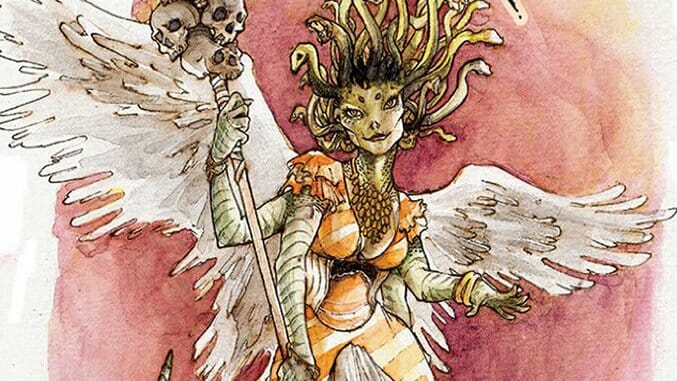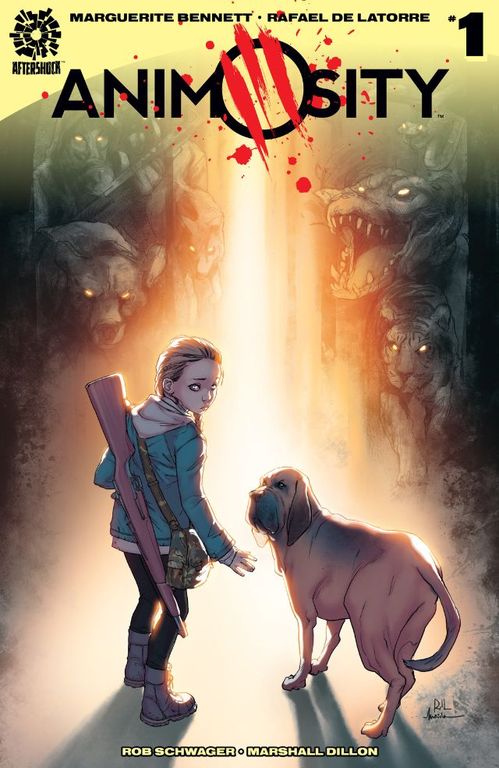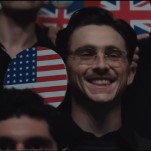“I Wanted to Corrupt the Imperialist Narrative”: An Interview With InSEXts & Animosity Writer Marguerite Bennett
Cover Art by Ariela Kristantina
Marguerite Bennett’s InSEXts, published by AfterShock Comics, begins with a secret romance and a quiet conspiracy, and then rapidly ventures into developments far more horrific and surreal. The plot balances the romantic relationship between Lady and Mariah, two Victorian-era protagonists, with the pair’s plan to murder Lady’s controlling, abusive husband. Bennett soon warps the period piece with a healthy dose of Cronenberg-era body-horror before enveloping readers in an onslaught of insectoid transformations, secret societies and unsettling violence, rendered with visceral abandon by Ariela Kristantina.
But Bennett’s comics rarely go to places readers might expect. Her new series with artist Rafael de Latorre, Animosity, takes place in a near future where animals have gained intelligence and the ability to speak, which doesn’t bode terribly well for humanity. The first issue just sold out of its first two printings. Her work on DC Comics Bombshells reimagines many of the publisher’s prominent female characters in the context of ‘40s WWII culture. Thus far, she’s demonstrated an impressive range of styles and tones, and we’d suspect she’s just getting started. Paste emailed with Bennett to unpack the parade of influences behind InSEXts, how her stories subvert historical expectations and Victorian literature.![]()
Paste: Both InSEXts and Bombshells are set in very particular historical periods. What appealed to you about each, and how do you balance giving the reader a sense of history with critiquing the more reactionary aspects of those points in time?
Marguerite Bennett: Good questions! The answer genuinely goes issue by issue. The art and action of those eras—the global conflicts, the empires, the social changes for each echelon and community, the aesthetic, the fashion, the values, the relationships to sexuality, race, gender and technology—are vibrant and distinct (though, I suppose, this can be said of any era). In InSEXts, I wanted to specifically tell a story that didn’t look like Masterpiece Theatre. London in the Victorian era was a tremendously diverse place, and queer people were not invented in the 1980s. I wanted to corrupt the imperialist narrative.

InSEXts #7 Cover Art by Ariela Kristantina
Paste: Initially, the transformations that Mariah and Lady undergo in InSEXts appear to be the comic’s one shift away from a realistic period piece, but additional issues bring in other supernatural elements. Do you have a sense of how great of an extent this 1894 differs from the historical record?
Bennett: The supernatural exists. That’s our main conceit—there are other monsters in the world, monsters with their own history and mythology, but Lady and Mariah are new creatures. There are no legends that describe them. They cannot see themselves in any text or work or art, even a horror story. They are uncertain of their powers and weaknesses, discovering their strengths and vulnerabilities and growing with them just as they develop through their relationship and their roles as mothers. They are writing their own stories and legends.
Paste: Your background is in [prose] writing, and your page on Patreon mentions nonfiction and short stories that are in the works. Have you found that writing comics has had an effect on the other forms of writing that you do, or are they fairly distinct?
Bennett: Form follows function, so there have been stories that I’ve wanted to tell that I realize only work as prose or only work as comics or only work as film or something else altogether. Comics has been an influence in making me carefully consider what medium serves a story best.
Let’s talk about that for a second, actually, and use horror as an example. If you are doing, say, a monster story where the look of the critter is one of the most interesting things about the critter—X feet tall with Y tentacles and Z teeth and all these colors and eyes and poisons etc., etc.—a visual medium is going to likely be most effective. Otherwise your reader is going to be sitting there with paragraph after paragraph of description, and the gutpunch shock of the critter’s appearance will be lost in a clinical discussion of the shape of its teeth and the color of its pupils.
-

-

-

-

-

-

-

-

-

-

-

-

-

-

-

-

-

-

-

-

-

-

-

-

-

-

-

-

-

-

-

-

-

-

-

-

-

-

-

-











































